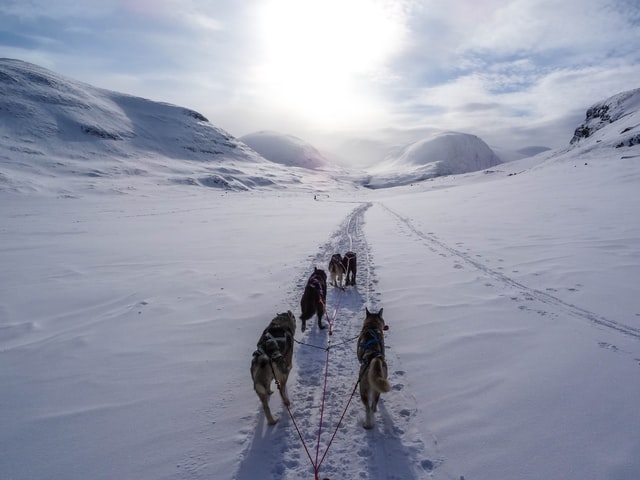
Dogs have always been an important part of society, but they have especially lent a hand in helping shape life in the far north. Their thick fur and padded paws made them well-designed to survive in the cold and snow. One of the most evident ways people have worked with dogs to establish life in the Arctic Circle specifically is dog sledding. Today, we are taking a dive into the deep history of dog sledding and how it has helped shape arctic society.
The oldest archeological evidence of dog sledding has been dated to around 1,000 A.D. and as far as archeologists can tell, dog sledding was invented by the Inuit people in the northern parts of modern Canada, and it then rapidly spread throughout the continent. Instead of a large sled led by many dogs, which is what dog sledding looks like today, it was usually just a single dog pulling minimal cargo such as firewood or other supplies. However, as time went on the power of using multiple dogs became more appealing. People quickly realized that larger loads could be carried over longer distances when multiple dogs were involved. Even so, dog-sled teams were much smaller than they are today, usually consisting of two to six dogs per sled.
After Canada adopted dog sledding as a common mode of transportation, European settlers quickly began incorporating sled dogs into their lives. Fun fact, the French-Canadian military actually used dog teams during the Seven Year’s War instead of horses because they were less expensive but were equally equipped to handle large loads and freezing weather. As word of dogs pulling sleds packed with supplies made its way around the colonies, the idea made its way to Europe where it was particularly appealing to polar adventurers who saw the value of incorporating dog sledding on their quests to find the poles. A Norwegian explorer named Roald Amundsen became the first person to reach the south pole, and he did that by using dog sleds on his journey.
Not only is the origin of dog sledding necessary to include, but also how dog sledding is used in racing. It has been said that there has always been a casual sport aspect to dog sledding, but it wasn’t until 1908 that the first dog-sled race took place in Nome, Alaska. This route became famous a little over a decade later when Leonhard Seppala, a Norwegian native, delivered diphtheria medicine to a struggling town. This journey has become a well-known part of American history, and a statue of the lead dog, Balto, stands in New York City to sustain this heroic act.
The Iditarod is the most famous dog sled race in the U.S. which is a 1000-mile race across Alaska. The first glimpses of the modern Iditarod were seen in 1967 due to dog sledders trying to create a race that would maintain interest in dog sledding in the face of modern alternatives such as snowboarding. Today, it is still equally popular as it was back when it was created and is held on the 10th week of the year. Due to popularity, there are even dog sledding races up here on the North Shore, such as the John Beargrease contest. As you can see, dog sledding has an extremely rich history and is still loved and enjoyed by many.
Happy dog sledding, friends!


Be the first to comment on “The History of Dog Sledding”